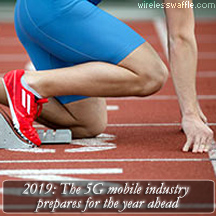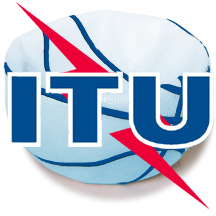 2018 was hopefully the year in which 5G hype peaked. Lots of mobile operators and equipment manufacturers were desperate to jump on the band-wagon and proclaim their plans to launch or operate 5G services or devices to be the first out of the running blocks. The simple fact, however, was that the 5G standard was delayed for 3 months until June 2019, and as of yet, there is no internationally agreed spectrum for 5G services.
2018 was hopefully the year in which 5G hype peaked. Lots of mobile operators and equipment manufacturers were desperate to jump on the band-wagon and proclaim their plans to launch or operate 5G services or devices to be the first out of the running blocks. The simple fact, however, was that the 5G standard was delayed for 3 months until June 2019, and as of yet, there is no internationally agreed spectrum for 5G services.2019 will hopefully be the year in which some of the hype begins to melt, and reality sets in. Prime amongst this will be the decisions taken at the ITU's World Radiocommunications Conference (WRC-19) which is due to take place in Sharm El-Sheikh in Egypt in November. One of the Agenda Items for the confernence, if not the most important agenda item of the conference, is number 1.13, whose snappy title is:
To consider identification of frequency bands for the future development of International Mobile Telecommunications (IMT), including possible additional allocations to the mobile service on a primary basis, in accordance with Resolution 238 (WRC-15).
 IMT is the ITU's terminology for commercial mobile communications and there are actually three flavours, IMT (2G and 3G), IMT-Advanced (4G) and IMT-2020 (5G). Before any radio spectrum can be formally used for IMT services of any kind, there are two prerequisites. Firstly the spectrum must have a 'mobile' allocation in the country in which it is to be used. Such an allocation will be found in the country's national frequency allocation plan. And in theory, if it is to be used for mobile services, it should also have been identified by the ITU as spectrum for IMT. All of the current mobile bands (e.g. 700, 800, 900, 1800, 2100, 2600 MHz) are in pieces of spectrum that have this identification.
IMT is the ITU's terminology for commercial mobile communications and there are actually three flavours, IMT (2G and 3G), IMT-Advanced (4G) and IMT-2020 (5G). Before any radio spectrum can be formally used for IMT services of any kind, there are two prerequisites. Firstly the spectrum must have a 'mobile' allocation in the country in which it is to be used. Such an allocation will be found in the country's national frequency allocation plan. And in theory, if it is to be used for mobile services, it should also have been identified by the ITU as spectrum for IMT. All of the current mobile bands (e.g. 700, 800, 900, 1800, 2100, 2600 MHz) are in pieces of spectrum that have this identification.The Agenda Item is investigating a wide range of frequency bands ranging from 24.25 to 86 GHz.
| Frequency Range | Amount of Spectrum |
|---|---|
| 24.25 - 27.5 GHz | 3.25 GHz |
| 31.8 - 33.4 GHz | 1.6 GHz |
| 37.0 - 43.5 GHz | 6.5 GHz |
| 45.5 - 50.2 GHz | 4.7 GHz |
| 50.4 - 52.6 GHz | 2.2 GHz |
| 66.0 - 76.0 GHz | 10.0 GHz |
| 81.0 - 86.0 GHz | 5.0 GHz |
| TOTAL | 33.25 GHz |
In total an increadible 33 GHz of new spectrum is being examined, which is in the order of 30 times more than has been identified as of today. Of this, it seems likely that something in the region of 20 GHz of spectrum will be identified for IMT. However, the waters are already being muddied by the organisations that manufacture mobile equipment and devices, and by one or two influential countries (e.g. the USA, Japan and China), and the nascent 5G standard includes the use of spectrum that is not part of the Agenda Item's studies.
In particular, the US, Japan and South Korea and others are proposing the use of a 28 GHz band (27.5 - 29.5 GHz) and South Korea, Japan and China are considering the use of a 4 GHz band (4.4 - 5.0 GHz), both bands, as it happens, being currently used for commercial satellite services. As these bands are not on the agenda for WRC-19, in theory they can not be identified for IMT meaning that they would be 'non-harmonised' bands. But in today's fast moving mobile industry, what really constitutes 'harmonised'? Does it mean that it has gone through the laborious 4 year ITU conference cycle, or does it mean that enough countries with sufficiently large populations to encourage economies of scale in manufacturing have got together and agreed a way forward.
 Many question the validity of the ITU process, saying that it is outdated, lethargic and even irrelevant. Some are even threatening to withdraw themselves, and their funding, from the organisation. That being said, it remains the process that most of the almost 200 members of the United Nations turn to, to help them align their use of the radio spectrum with the rest of the planet.
Many question the validity of the ITU process, saying that it is outdated, lethargic and even irrelevant. Some are even threatening to withdraw themselves, and their funding, from the organisation. That being said, it remains the process that most of the almost 200 members of the United Nations turn to, to help them align their use of the radio spectrum with the rest of the planet.The forthcoming WRC therefore, and the associated decisions on the frequency bands to use for 5G, stands to be fascinating, both from the perspective of the sheer amount of new mobile spectrum that could be available following the conference, and whether or not the rogue nations will be able to twist enough arms to get their positions ratified, or will just storm out of the room in a huff. Wireless Waffle, will, as always, keep you posted.
add comment
( 656 views )
| permalink
| 



 ( 3 / 393 )
( 3 / 393 )




 ( 3 / 393 )
( 3 / 393 )

